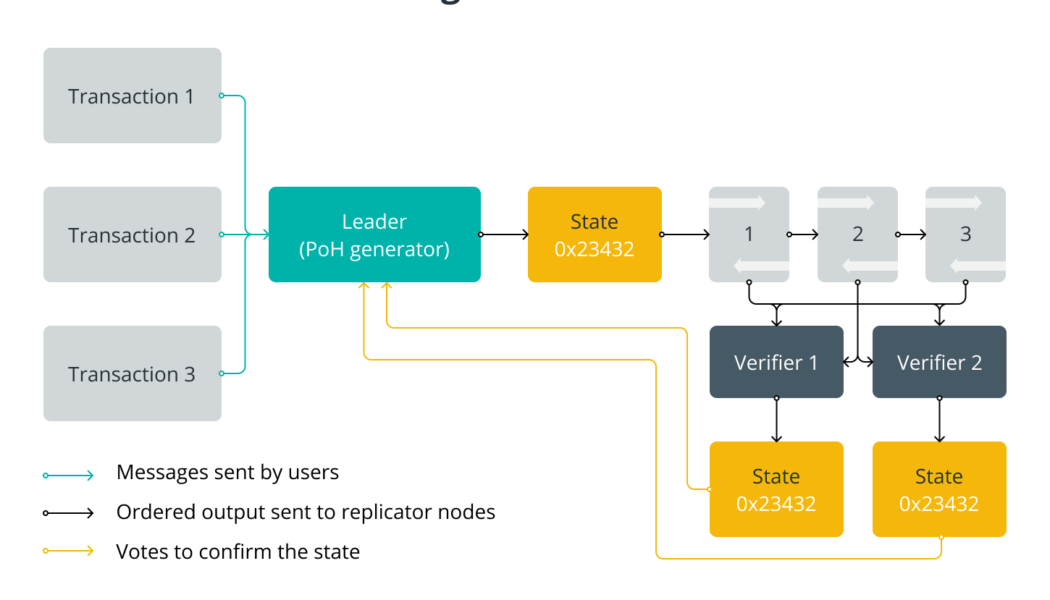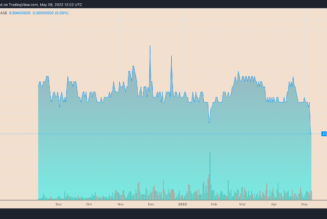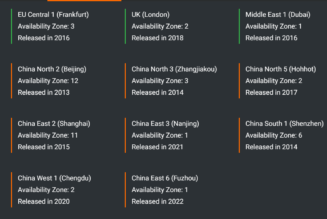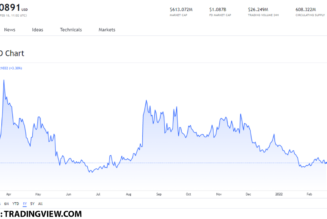What is Solana?
Solana is a highly functional open source project that implements a new, permissionless and high-speed layer-1 blockchain.
Created in 2017 by Anatoly Yakovenko, a former executive at Qualcomm, Solana aims to scale throughput beyond what is typically achieved by popular blockchains while keeping costs low. Solana implements an innovative hybrid consensus model that combines a unique proof-of-history (PoH) algorithm with the lightning-fast synchronization engine, which is a version of proof-of-stake (PoS). Because of this, the Solana network can theoretically process over 710,000 transactions per second (TPS) without any scaling solutions needed.
Solana’s third-generation blockchain architecture is designed to facilitate smart contracts and decentralized application (DApp) creation. The project supports an array of decentralized finance (DeFi) platforms as well as nonfungible token (NFT) marketplaces.
Solana blockchain was rolled out during the 2017 initial coin offering (ICO) boom. The project’s internal testnet was released in 2018, followed by multiple testnet phases leading to the eventual official launch of the main network in 2020.
What makes Solana unique?
Solana’s ambitious design aims to solve the blockchain trilemma, a concept proposed by Ethereum creator Vitalik Buterin, in its unique way. This trilemma describes a set of three major challenges that developers face when building blockchains: decentralization, security and scalability.
It is widely believed that blockchains are built in such a way that forces developers to sacrifice one of the aspects in favor of the other two, as they can only provide two of the three benefits at any given time.
The Solana blockchain platform has proposed a hybrid consensus mechanism that compromises on decentralization to maximize speed. The innovative combination of PoS and PoH makes Solana a unique project in the blockchain industry.
Generally, blockchains have greater scalability, depending on the number of transactions per second they can support, the more and better they scale. In decentralized blockchains, however, time discrepancies and higher throughput slow them down, meaning that more nodes verifying transactions and timestamps take more time.
In a nutshell, Solana’s design solves this problem by having one leader node chosen based on the PoS mechanism that sequences messages between nodes. Thus, the Solana network benefits, reducing workload that results in increased throughput even without a centralized and exact time source.
Also, Solana creates a chain of transactions by hashing the output of one transaction and using it as the input of the next transaction. This history of transactions gives a name to Solana’s main consensus mechanism: PoH, a concept that allows for greater scalability of the protocol which, in turn, boosts usability.
How does Solana work?
The core component of the Solana protocol is proof-of-history, a sequence of computations that provides a digital record that confirms that an event has occurred on the network at any point in time. It can be presented as a cryptographic clock that gives a timestamp to every transaction on the network, along with a data structure that can be a simple addition of it.
PoH relies on PoS using the Tower Byzantine fault tolerance (BFT) algorithm, an optimized version of the practical Byzantine fault tolerance (pBFT) protocol. Solana uses it to reach a consensus. The Tower BFT keeps the network secure and running and acts as an additional tool to validate transactions.
Moreover, PoH can be considered as a high-frequency Verifiable Delay Function (VDF), a triple function (setup, evaluation, verification) to produce unique and reliable output. VDF maintains order in the network by proving that block producers have waited enough time for the network to move forward.
Solana uses a 256-bit secure hash algorithm (SHA-256), a set of proprietary cryptographic functions that output a 256-bit value. The network periodically samples the number and SHA-256 hashes, providing real-time data according to the set of hashes included on central processing units.
Solana validators can use this sequence of hashes to record a specific piece of data that was created prior to the generation of a specific hash index. The timestamp for transactions is created after this particular piece of data is inserted. To achieve claimed huge numbers of TPS and block creation time, all nodes on the network must have cryptographic clocks to keep track of events rather than waiting for other validators to verify transactions.

The Solana (SOL) token
Solana’s cryptocurrency is SOL. It is Solana’s native and utility token that provides a means of transferring value as well as blockchain security through staking. SOL was launched in March 2020 and has strived to become one of the top 10 cryptocurrencies entering the space by means of total market capitalization.
SOL token operation scheme is similar to that used in the Ethereum blockchain. Even though they function similarly, Solana token holders stake the token in order to validate transactions through the PoS consensus mechanism. Furthermore, the Solana token is used to receive rewards and pay transaction fees while also SOL enabling users to participate in governance.
Related: Proof-of-stake vs. proof-of-work: Differences explained
Answering the question of how many Solana coins are there, there will be more than 500 million tokens released in circulation with the current total supply of Solana exceeding 511 million tokens — Solana’s circulating supply is just over half that. Around 60% of SOL tokens are controlled by Solana’s founders and the Solana Foundation, with only 38% reserved for the community.
If you would like to know where to buy Solana, SOL tokens can be purchased on most exchanges. The top cryptocurrency exchanges for trading in Solana are Binance, Coinbase, KuCoin, Huobi, FTX and others.
Solana vs. Ethereum
Solana has received a lot of accolades for its speed and performance and has even been cited as a legitimate competitor of crypto industry leaders such as Ethereum.
So, how is Solana different from Ethereum and can it be considered as a potential Ethereum killer?
In terms of processing speed, Solana is able to challenge the dominant smart contract platform, as it is supposedly capable of reaching a speed of over 50,000 TPS. Solana uses different consensus algorithms to avoid slow transaction confirmation. This feature makes Solana one of the fastest blockchains in the industry to compete with other industries outside of the crypto space.
Compared to this enormous number, the current low scalable Ethereum proof-of-work model can only handle 15 TPS. Thus, Solana is thousands of times faster than Ethereum. Another Solana advantage is the network’s extreme cost-effectiveness, as the project implements new tokenomics for lower fees.
Related: What is Web 3.0: A beginner’s guide to the decentralized internet of the future
Also, it is worth noting that Solana’s blockchain, while implementing one of the variations of PoS, is more eco-friendly and sustainable. This is in contrast with Ethereum, whose current PoW model requires the use of tremendous computational power.
However, everyone in the crypto community is looking forward to the Ethereum upgrade to PoS. A new kind of Ethereum, which is being diligently developed, will consist of an execution layer (previously known as Ethereum 1.0) and a consensus layer (previously Ethereum 2.0). It could greatly increase throughput, improve scalability, lower transaction fees and stop unsustainable power consumption.
The downsides of Solana
If you’re still wondering if Solana is a good investment and whether you should buy it, the answer is still up to you. Despite the visible advantages, Solana has its demerits like any existing crypto project.
First and foremost, although the Solana blockchain can compete with high-end blockchain projects, it is still vulnerable to centralization, as there are not many blockchain validators. Anyone on the network can become a Solana validator but doing so is still difficult because it requires a lot of computing resources.
Along with this, the protocol still labels itself as a beta version of the mainnet, which does not negate the possible presence of bugs and errors.
Despite these issues, Solana is still one of the biggest ecosystems in the crypto industry and seems to be on the right growth path.
 [flexi-common-toolbar] [flexi-form class=”flexi_form_style” title=”Submit to Flexi” name=”my_form” ajax=”true”][flexi-form-tag type=”post_title” class=”fl-input” title=”Title” value=”” required=”true”][flexi-form-tag type=”category” title=”Select category”][flexi-form-tag type=”tag” title=”Insert tag”][flexi-form-tag type=”article” class=”fl-textarea” title=”Description” ][flexi-form-tag type=”file” title=”Select file” required=”true”][flexi-form-tag type=”submit” name=”submit” value=”Submit Now”] [/flexi-form]
[flexi-common-toolbar] [flexi-form class=”flexi_form_style” title=”Submit to Flexi” name=”my_form” ajax=”true”][flexi-form-tag type=”post_title” class=”fl-input” title=”Title” value=”” required=”true”][flexi-form-tag type=”category” title=”Select category”][flexi-form-tag type=”tag” title=”Insert tag”][flexi-form-tag type=”article” class=”fl-textarea” title=”Description” ][flexi-form-tag type=”file” title=”Select file” required=”true”][flexi-form-tag type=”submit” name=”submit” value=”Submit Now”] [/flexi-form]










Tagged: Blockchain, crypto blog, Crypto news, Ethereum, permissionless, Solana